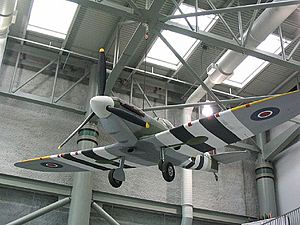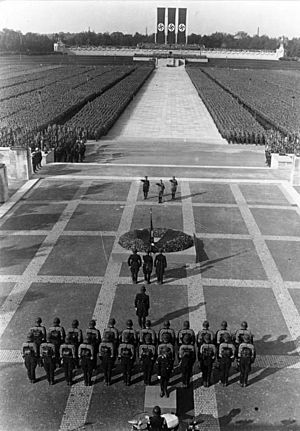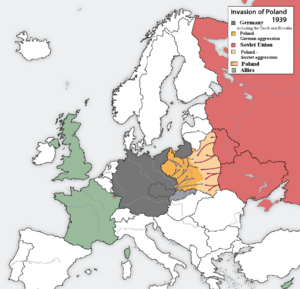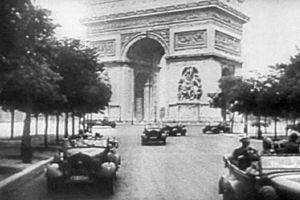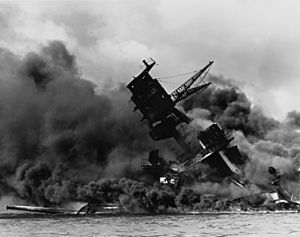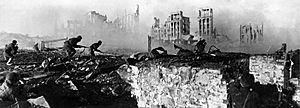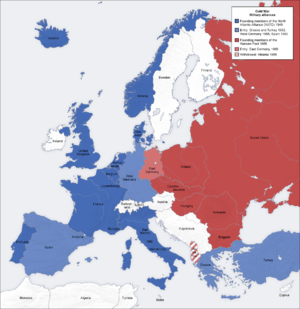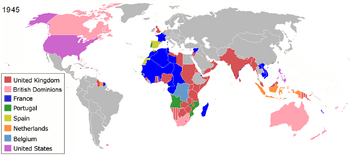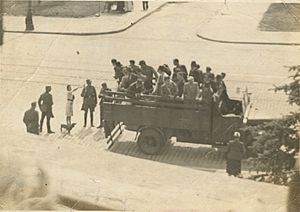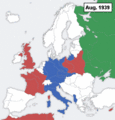World War II facts for kids
Quick facts for kids World War II |
|||||||
|---|---|---|---|---|---|---|---|
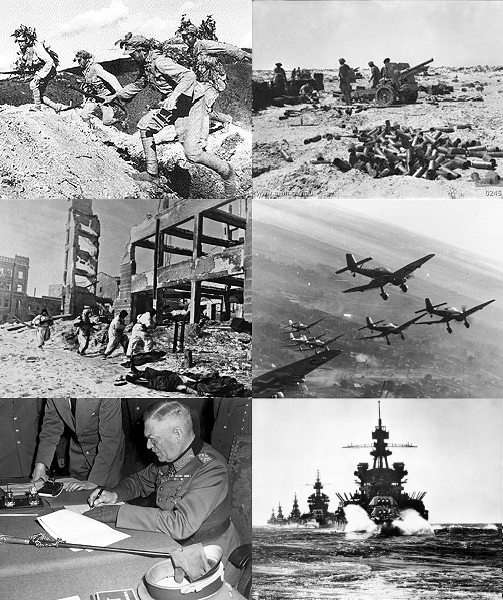 Clockwise from top left:
|
|||||||
|
|||||||
| Belligerents | |||||||
|
Allies |
Axis |
||||||
| Commanders and leaders | |||||||
|
Allied leaders |
Axis leaders |
||||||
| Casualties and losses | |||||||
|
Military Dead:: |
Military Dead: |
||||||
World War II (often called WWII or WW2) was a huge global war. It involved almost every country in the world. Most of the fighting happened between 1939 and 1945. Some fighting, though, started as early as 1937.
The war was fought between two main groups of countries. These were the Allies and the Axis Powers. World War II was the biggest and deadliest conflict in all of history. More countries, people, and money were involved than in any other war. Between 50 and 85 million people died. Most of these were ordinary people, not soldiers. The war included terrible events like mass killings, the Holocaust (a planned genocide), and the only time nuclear weapons were used in war.
The Allies first included China, France, and Britain. Later, the Soviet Union and United States joined them. The Axis Powers were Germany, Italy, and Japan. The war in Asia began when Japan invaded China in July 1937. In Europe, the war started when Germany invaded Poland on September 1, 1939. Britain and France then declared war on Germany.
By 1941, Germany controlled much of Europe, including France. Only Britain continued to fight the Axis in North Africa, the Mediterranean, and the Atlantic. Germany stopped its plans to invade Britain after losing a big air battle called the Battle of Britain. In June 1941, Germany invaded the Soviet Union. This started the largest area of fighting in the war. On December 7, 1941, Japan attacked the United States at Pearl Harbor. Japan also invaded British and French colonies in Asia. This made the two separate wars become one global conflict.
The Allies began to push back in 1942. Japan's victories were stopped. The Soviets won the huge Battle of Stalingrad. After this, the Allies started to fight back from all sides. The Axis forces were pushed back in the Soviet Union. They also lost North Africa. Starting in 1943, they had to defend Italy. In 1944, the Allies invaded France. They moved into Germany from the west. The Soviets came from the east. Germany surrendered on May 8, 1945. Japan formally surrendered on September 2, 1945. The war ended with the Allied victory.
After the war, the United Nations was created. Its goal was to help countries work together and prevent future wars. A new period called the Cold War began between the main winners. However, they did not fight each other directly. Many countries in Asia and Africa also gained their independence. This happened because European countries were weakened by the war. Countries also worked to rebuild their economies and unite politically.
Contents
Who Fought in World War II?
The countries that joined the war were on one of two sides. These were the Axis and the Allies.
The Axis Powers
The Axis Powers at the start of the war were Germany, Italy, and Japan. They had many meetings to form their alliance. Later, Finland, Slovakia, Romania, Bulgaria, Hungary, and Thailand joined the Axis. As the war went on, some Axis countries, like Italy, switched sides to join the Allies.
The Allied Powers
The Allied Powers at the start included the United Kingdom and some Commonwealth members. They also included France, Poland, Yugoslavia, Greece, Belgium, and China. China had been fighting a civil war before the global war. In June 1941, Germany attacked the Soviet Union in Operation Barbarossa. In December 1941, Japan attacked the United States at Pearl Harbor. These two large and powerful countries then joined the Allies.
Why Did World War II Happen?
World War I greatly changed the world's diplomacy and politics. Empires that lost the first war were broken up. The Russian Empire also ended. New countries were formed in Eastern Europe. This led to strong feelings of wanting lost land back. These feelings were especially strong in Germany. Germany had to sign the Treaty of Versailles. This treaty made them give up 13% of their land and all their colonies. They also had to pay a very large sum of money to the Allies. Their army and navy were limited, and their air force was banned.
In Italy, many people were unhappy with the war's outcome. They felt Italy should have gained more land. The fascist movement grew in the 1920s. Benito Mussolini became Italy's leader. He promised to make Italy a great power by building its colonial empire.
After the Kuomintang (KMT) united China in the 1920s, a civil war began. It was between the KMT and the Communist Party of China. In 1931, Japan used an event called the Mukden Incident as an excuse. They took Manchuria and set up a puppet state called Manchukuo. The League of Nations could not stop them. A ceasefire was signed in 1933. In 1936, the KMT and communists agreed to stop fighting each other. They decided to fight Japan instead. In 1937, Japan started the Second Sino-Japanese War to take the rest of China.
After the German Empire ended, a democratic government called the Weimar Republic was set up. Germans had many different political ideas, from nationalism to communism. The fascist movement in Germany grew because of the Great Depression. Adolf Hitler, leader of the Nazi Party, became Germany's leader in 1933. After a fire at the Reichstag, Hitler created a totalitarian state. This meant only one party was allowed by law. Hitler wanted to change the world order. He quickly rebuilt Germany's army, navy, and air force. In March 1936, Hitler sent his army into Rhineland. The Spanish Civil War began in July 1936. This war ended with a victory for the nationalists, who were supported by Italy and Germany.
In March 1938, Germany sent its army into Austria. This was called the Anschluss. Other European countries did little to stop it. Soon after, the Allies agreed to give Sudetenland, part of Czechoslovakia, to Germany. They hoped Hitler would stop taking more land. But by March 1939, the rest of Czechoslovakia was either forced to surrender or invaded. The Allies then tried to stop Hitler. They promised to help Poland if it was attacked. Just before the war, Germany and the Soviet Union signed a peace agreement. They agreed not to attack each other for ten years. Secretly, they also agreed to divide Eastern Europe between them.
How the War Unfolded
War Begins in Europe
World War II began on September 1, 1939. Germany invaded Poland. On September 3, Britain, France, and Commonwealth countries declared war on Germany. They could not help Poland much. The Soviet Union invaded eastern Poland soon after Germany, on September 17. Poland was then divided.
Germany and the Soviet Union signed an agreement to work together. The Soviet Union forced the Baltic countries to allow Soviet soldiers. Finland did not agree to give up its land. So, the Soviet Union attacked Finland in November 1939. France and Britain thought the Soviet Union might join Germany. They removed the Soviet Union from the League of Nations.
After Poland was defeated, a quiet period called the "Phoney War" began in Western Europe. British soldiers went to Europe, but no big battles were fought. Then, in April 1940, Germany attacked Norway and Denmark. This was to protect its iron ore transport from Sweden. Britain and France sent an army to stop Germany. But they had to leave when Germany invaded France. Neville Chamberlain was replaced by Winston Churchill as Prime Minister of the United Kingdom in May 1940.
Axis Early Victories
On May 10, Germany invaded France, Belgium, Holland, and Luxembourg. They quickly defeated them using blitzkrieg tactics. British soldiers had to leave mainland Europe at Dunkirk. On June 10, Italy invaded France. It declared war on France and the United Kingdom. Soon after, France was divided. One part was controlled by Germany and Italy. The other was unoccupied Vichy France.
By June 1940, the Soviet Union moved its soldiers into the Baltic states and took them. They also took Bessarabia in Romania. The Soviet Union and Germany had worked together before. But these events made their relationship worse. When they could not agree to work more closely, their relationship became so bad that it led to war.
Germany then began an air battle over Britain. This was to prepare for a landing on the island. But the plan was canceled in September. The German Navy destroyed many British ships carrying goods in the Atlantic. Italy began its operations in the Mediterranean. The United States stayed neutral. But it started to help the Allies. By protecting British ships, the United States found itself fighting German ships by October 1941. But this was not officially war.
In September 1940, Italy invaded British-held Egypt. In October, Italy invaded Greece. But this only led to an Italian retreat to Albania. In early 1941, an Italian army was pushed from Egypt to Libya in Africa. Germany soon helped Italy. Under Erwin Rommel's command, the Commonwealth army was pushed back to Egypt by April 1941. Besides North Africa, Germany also successfully invaded Greece, Yugoslavia, and Crete by May. Despite these wins, Hitler stopped the bombing of Britain after May 11.
At the same time, Japan was not making much progress in China. The Chinese nationalist and communist forces started fighting each other again. Japan planned to take over European colonies in Asia while they were weak. The Soviet Union felt danger from Germany. So, they signed a non-aggression pact in April 1941. This was an agreement not to attack each other. However, Germany kept preparing to attack the Soviet Union. They moved their soldiers close to the Soviet border.
The War Becomes Global
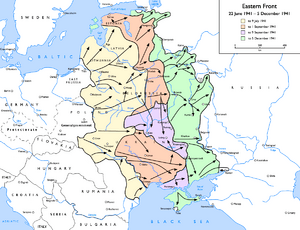
On June 22, 1941, the European Axis countries attacked the Soviet Union. During the summer, the Axis quickly captured Ukraine and the Baltic regions. This caused huge damage to the Soviets. Britain and the Soviet Union formed a military alliance in July. The Axis made great progress in the first two months. But when winter came, the tired German army had to delay its attack just outside Moscow. This showed that the Axis had failed its main goals. The Soviet army was still strong. This marked the end of the blitzkrieg stage of the war.
By December, the Red Army facing the Axis had received more soldiers from the east. They began a counter-attack. This pushed the German army to the west. The Axis lost many soldiers. But they still held most of the land they had gained.
By November 1941, the Commonwealth counter-attacked the Axis in North Africa. They got back all the land they had lost. However, the Axis pushed the Allies back again. They were stopped at El Alamein.
In Asia, Germany's successes encouraged Japan. Japan wanted oil supplies from the Dutch East Indies. Many Western countries reacted to Japan's occupation of French Indochina. They stopped trading oil with Japan. Japan planned to take over European colonies in Asia. This was to create a strong defensive area in the Pacific. They wanted more resources. But before any invasion, they first had to destroy the American Pacific Fleet. On December 7, 1941, Japan attacked Pearl Harbor. They also attacked many harbors in several Southeast Asian countries. This led the United States, United Kingdom, Australia, and China to declare war on Japan. The Soviet Union remained neutral. Most of the Axis nations then declared war on the United States.
By April 1942, many Southeast Asian countries had fallen to the Japanese. These included Burma, Malaya, the Dutch East Indies, and Singapore. In May 1942, the Philippines fell. The Japanese navy had many quick victories. But in June 1942, Japan was defeated at Midway. Japan could not take more land after this. A large part of its navy was destroyed during the battle.
Allies Push Forward
Japan then began a plan to take over Papua New Guinea again. The United States planned to attack the Solomon Islands. The fight on Guadalcanal began in September 1942. It involved many troops and ships from both sides. It ended with a Japanese defeat in early 1943.
On the Eastern Front, the Axis defeated Soviet attacks in the summer. They began their own main attack into southern Russia in June 1942. This was along the Don and Volga Rivers. They tried to take over oil fields in Caucasus. These were important for fueling their war effort. They also wanted a great steppe. Stalingrad was in the path of the Axis army. The Soviets decided to defend the city. By November, the Germans had nearly taken Stalingrad. However, the Soviets were able to surround the Germans during winter. After heavy losses, the German army had to surrender the city in February 1943. The front was pushed back further than before the summer attacks. But the German army was still a danger around Kursk. Hitler sent almost two-thirds of his armies to the Battle of Stalingrad. The Battle of Stalingrad was the largest and deadliest battle in this war.

In August 1942, the Axis army failed to take El Alamein. This was due to the Allied defense. A new Allied attack pushed the Axis west across Libya a few months later. This happened just after the Anglo-American invasion of French North Africa. This forced the Axis to join the Allies. This led to the Axis defeat in the North African Campaign in May 1943.
In the Soviet Union, Germany started an attack around Kursk on July 4, 1943. Many German soldiers were lost because of the Soviets' strong defenses. Hitler stopped the attack before a clear winner emerged. The Soviets then started their own counter-attack. This was a major turning point of the war. After this, the Soviets became the attacking force on the Eastern Front.
On July 9, 1943, the Western Allies landed on Sicily. This was influenced by the earlier Soviet victories. This led to Mussolini's arrest in the same month. In September 1943, the Allies invaded mainland Italy. This followed Italy's armistice with the Allies. Germany then took control of Italy. They disarmed its army. They built many defensive lines to slow the Allied invasion. German special forces rescued Mussolini. He then created a German-controlled state called the Italian Social Republic.
Late in 1943, Japan conquered some islands in India. They began an invasion of the Indian mainland. The Army of India and other forces pushed them out in early 1944.
In early 1944, the Soviet army drove the German army from Leningrad. This ended the longest and deadliest siege in history. After that, the Soviets began a big counter-attack. By May, the Soviets had retaken Crimea. With the attacks in Italy from September 1943, the Allies captured Rome on June 4, 1944. They made the German forces fall back.
The End in Europe
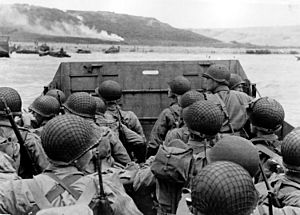
On D-Day, June 6, 1944, the Allies began the invasion of Normandy, France. The code name for the invasion was Operation Overlord. The invasion was successful. It led to the defeat of German forces in France. Paris was freed in August 1944. The Allies continued eastward as the German front collapsed. Operation Market-Garden was a combined air and ground invasion of the Netherlands. It launched on September 17, 1944. Its goal was to capture a series of bridges, including one in Arnhem over the Rhine river. The ground invasion reached the Rhine but could not take the Arnhem bridge.
On June 22, the Soviet attack on the Eastern Front, called Operation Bagration, almost destroyed the German Army Group Centre. Soon after, the Germans had to retreat and defend Ukraine and Poland. Arriving Soviet troops caused uprisings against the German government in Eastern European countries. But these failed unless helped by the Soviets. Another Soviet attack forced Romania and Bulgaria to join the Allies. Communist Serbs partisans under Josip Broz Tito retook Belgrade with help from Bulgaria and the Soviet Union. By early 1945, the Soviets attacked many German-occupied countries. These included Greece, Albania, Yugoslavia, and Hungary. Finland switched to the side of the Soviets and Allies.
On December 16, 1944, the Germans tried one last attack on the Western Front. They attacked the Allies in Ardennes, Belgium. This battle is known as the Battle of the Bulge. It was the last major German attack of the war. The Germans were not successful.
By March 1945, the Soviet army moved quickly from the Vistula River in Poland to East Prussia and Vienna. The Western Allies crossed the Rhine. In Italy, the Allies pushed forward. The Soviets attacked Berlin. The Allied western forces met the Soviets at the Elbe river on April 25, 1945.
Hitler committed suicide on April 30, 1945. This was two days after Mussolini's death. In his will, he named his navy commander, Grand Admiral Karl Dönitz, as the new President of Germany. Dönitz surrendered to the Allies. He went against Hitler's wish for Germany to keep fighting.
German forces in Italy surrendered on April 29, 1945. Germany surrendered to the Western Allies on May 7, 1945. This day is known as V-E Day (Victory in Europe Day). Germany was forced to surrender to the Soviets on May 8, 1945. The final battle in Europe ended in Italy on May 11, 1945.
The End in the Pacific

In the Pacific, American forces arrived in the Philippines in June 1944. By April 1945, American and Philippine forces had cleared most Japanese forces. But fighting continued in some parts of the Philippines until the war's end. British and Chinese forces advanced in Northern Burma. They captured Rangoon by May 3, 1945. American forces then took Iwo Jima by March and Okinawa by June 1945. Many Japanese cities were destroyed by Allied bombings. American submarines cut off Japanese imports.
The Allies wanted Japan to surrender without conditions. But Japan refused. This led the United States to drop two atomic bombs. One was over Hiroshima (August 6, 1945). The other was over Nagasaki (August 9, 1945). On August 8, 1945, the Soviets invaded Manchuria. They quickly defeated the main Imperial Japanese Army there. On August 15, 1945, Japan surrendered to the Allies. The surrender documents were formally signed on board the USS Missouri on September 2, 1945. This ended the war.
What Happened After World War II?
The Allies occupied Austria and Germany. Germany was divided in half. The Soviet Union controlled the Eastern part. The Western Allies controlled the Western part. The Allies began "denazification." This meant removing Nazi ideas from public life in Germany. Most high-ranking Nazis were captured and brought to a special court. Germany lost a quarter of the land it had in 1937. This land was given to Poland and the Soviet Union. The Soviets also took parts of Poland and Finland, as well as three Baltic countries.
The United Nations was formed on October 24, 1945. Its goal was to keep peace between countries. However, the relationship between the Western Allies and the Soviet Union had worsened during the war. Soon after the war, each power built up its influence over controlled areas. In Western Europe and West Germany, it was the United States. In East Germany and Eastern Europe, it was the Soviet Union. Many countries there became Communist states. The Cold War started after the American-led NATO and the Soviet-led Warsaw Pact were formed.
In Asia, Japan was occupied by America. In 1948, Korea was divided into North and South Korea. Each claimed to be the true government of Koreans. This led to the Korean War in 1950. The civil war in China continued from 1946. It resulted in the KMT retreating to Taiwan in 1949. The communists won control of mainland China. In the Middle East, Arab disagreement over the United Nations plan to create Israel began conflicts between Arabs and Israel.
After the war, many European colonies gained independence. Bad economies and people wanting to rule themselves were the main reasons. In most cases, it happened peacefully. But in some countries, like Indochina and Algeria, there was fighting. In many regions, European withdrawal caused divisions among people with different ethnic groups or religions.
Economic recovery was different around the world. Overall, it was quite positive. The United States became richer than any other country. By 1950, it led the world's economy. It also started the Marshall Plan (1948–1951) to help European countries. German, Italian, and French economies recovered. However, the British economy was badly hurt. It continued to struggle for over ten years. The Soviet economy grew very fast after the war. The Japanese economy also grew quickly. It became one of the largest economies in the 1980s. China returned to its pre-war production level by 1952.
Impact of the War
Concentration Camps and Forced Labor
Besides the Holocaust, about 12 million people, mostly from Eastern Europe, were forced to work for Germany. German concentration camps and Soviet gulags caused many deaths. Both treated prisoners of war very badly. This was even true for Soviet soldiers who survived and returned home.
Japanese prisoner-of-war camps, many used as labor camps, also caused many deaths. The death rate for Western prisoners was 27.1%. This was seven times higher than for prisoners under Germans and Italians. More than 10 million Chinese civilians were made slaves. They had to work in mines and war factories. Between 4 and 10 million people were forced to work in Java.
Between 1942 and 1945, President Roosevelt signed an order. This made Japanese Americans go to internment camps. Some Germans and Italians were also included.
The Allies agreed that the Soviet Union could use prisoners of war and civilians for forced labor. Hungarians were forced to work for the Soviet Union until 1955.
Home Fronts and Production
Before the war, in Europe, the Allies had more people and a bigger economy than the Axis. If colonies were included, the Allies' total economic output would be twice that of the Axis. In Asia, China's economy was only 38% larger than Japan's, including their colonies.
The Allies' economy and population seemed smaller compared to the Axis after early Axis victories. However, this changed after the United States and Soviet Union joined the Allies in 1941. The Allies could produce more than the Axis. This was because the Allies had more natural resources. Also, Germany and Japan did not plan for a long war. They were not able to keep up. Both tried to improve their economies by using slave laborers.
Women's Roles
As men went to fight, women took over many jobs they left behind. In factories, women made bombs, guns, aircraft, and other equipment. In Britain, thousands of women worked on farms as part of the Land Army. Others joined the Women's Royal Naval Service. They helped build and repair ships. Even Princess Elizabeth, who later became Queen Elizabeth II, worked as a mechanic to help the war effort. By 1945, some weapons were made almost entirely by women.
At first, women were rarely used in the workforce in Germany and Japan. However, Allied bombings and Germany's shift to a war economy made women take a greater part.
In Britain, women also worked in gathering intelligence. This happened at Bletchley Park and other places. The mass evacuation of children also greatly impacted mothers' lives during the war years.
Occupation Policies
Germany had two different ways of occupying countries. In Western, Northern, and Central Europe, Germany set economic policies to make itself rich. During the war, these policies brought up to 40% of Germany's total income. In the East, the war with the Soviet Union meant Germany could not use the land to gain resources. The Nazis used their racial policy. They murdered many people they considered "non-human." The Resistance, groups who secretly fought Germany, could not harm the Nazis much until 1943.
In Asia, Japan claimed to free Asian countries from European colonial powers. At first, they were welcomed in many places. But their cruel actions quickly turned opinions against them. During the occupation, Japan used 4 million barrels of oil left by the Allies at the war's end. By 1943, Japan could produce up to 50 million barrels of oil in the Dutch East Indies. This was 76% of its 1940 rate.
New Technologies and Warfare
The war brought new methods for future wars. Air forces greatly improved. This included air transport, strategic bombing (using bombs to destroy industry and morale), radar, and weapons for destroying aircraft. Jet aircraft were developed. They would be used in air forces worldwide.
At sea, the war focused on using aircraft carriers and submarines. Aircraft carriers soon replaced battleships. A key reason was that they were cheaper. Submarines, a deadly weapon since World War I, also played an important part. The British improved weapons for destroying submarines, like sonar. The Germans improved submarine tactics.
The style of land warfare changed from World War I. It became more mobile. Tanks, once used to support infantry, became a main weapon. Tanks improved in speed, armor, and firepower during the war. At the start, most commanders thought better tanks were the best way to fight enemy tanks. However, early tanks could only slightly harm armor. The German idea to avoid tanks fighting each other meant tank-on-tank battles rarely happened. This was a successful tactic in Poland and France. Ways to destroy tanks also improved. Even though vehicles were used more, infantry remained the main part of the army. Most infantry were equipped like in World War I.
Submachine guns became widely used. They were especially useful in cities and jungles. The assault rifle, a German invention combining features of the rifle and submachine gun, became the main weapon for most armies after the war.
Other developments included better encryption for secret messages. An example was the German Enigma machine. Another part of military intelligence was using deception, especially by the Allies. Other inventions included the first programmable computers, modern missiles and rockets, and the atomic bombs.
Countries with the Most Warship Losses
| Country | Warships that were sunk |
|---|---|
| United Kingdom | 213 |
| Japan | 198 |
| United States | 105 |
| Italy | 97 |
| Germany | 60 |
| USSR | 37 |
| Canada | 17 |
| France | 11 |
| Australia | 9 |
| Norway | 2 |
Countries with the Most Military Losses
Experts agree that out of 30 million Soviet soldiers, 13.6 million died.
| Country | Killed | ||
|---|---|---|---|
| USSR | - | Germany | 3,300,000 |
| China | 1,324,516 | ||
| Japan | 1,140,429 | ||
| British Empire*| 357,116 | |||
| Romania | 350,000 | ||
| Poland | 320,000 | ||
| Yugoslavia | 305,000 | ||
| United States | 292,131 | ||
| Italy | 279,800 |
- total, of which 7,800,000 battlefield deaths
- Inc. Australia, Canada, India, New Zealand, etc.
Countries with the Most Civilian Losses
Many civilians died during this war. Many deaths were from starvation and internal purges, especially in China and the USSR. These deaths were huge in number. But they were not as well recorded as military deaths. The numbers below are the best available. They show the large scale of civilian losses. But the exact numbers will never be known.
| Country | Killed |
|---|---|
| China | 8,000,000 |
| USSR | 6,500,000 |
| Poland | 5,300,000 |
| Germany | 2,350,000 |
| Yugoslavia | 1,500,000 |
| France | 470,000 |
| Greece | 415,000 |
| Japan | 393,400 |
| Romania | 340,000 |
| Hungary | 300,000 |
The Axis Powers
Germany, Italy, Japan, Hungary, Romania, Bulgaria
The Allied Powers
U.S., Britain, France, USSR, Australia, Belgium, Brazil, Canada, China, Denmark, Greece, Netherlands, New Zealand, Norway, Poland, South Africa, Yugoslavia
Related pages
Images for kids
-
The League of Nations assembly, held in Geneva, Switzerland, 1930
-
Italian soldiers recruited in 1935, on their way to fight the Second Italo-Abyssinian War
-
Japanese Imperial Army soldiers during the Battle of Shanghai, 1937
-
Red Army artillery unit during the Battle of Lake Khasan, 1938
-
German Foreign Minister Ribbentrop and the Soviet leader Joseph Stalin, after signing the Molotov–Ribbentrop Pact, 23 August 1939
-
Soldiers of the German Wehrmacht tearing down the border crossing between Poland and the Free City of Danzig, 1 September 1939
-
German tanks near the city of Bydgoszcz, during the Invasion of Poland, September 1939
-
Australian troops of the British Commonwealth Forces man a front-line trench during the Siege of Tobruk; North African Campaign, August 1941
-
European theatre of World War II animation map, 1939–1945 — Red: Western Allies and Soviet Union after 1941; Green: Soviet Union before 1941; Blue: Axis Powers
-
Seated at the Casablanca Conference; US President Franklin D. Roosevelt and British PM Winston Churchill, January 1943
-
US Marines during the Guadalcanal Campaign, in the Pacific theatre, 1942
-
Red Army, during the Battle of Kursk, the largest tank battle ever fought.
-
The Allied leaders of the Asian and Pacific Theatre: Generalissimo Chiang Kai-shek, Franklin D. Roosevelt, and Winston Churchill meeting at the Cairo Conference, 25 November 1943
-
Ruins of the Benedictine monastery, during the Battle of Monte Cassino; Italian Campaign, May 1944
-
Yalta Conference held in February 1945, with Winston Churchill, Franklin D. Roosevelt and Joseph Stalin
-
Ruins of Warsaw in January 1945, after the deliberate destruction of the city by the occupying German forces
-
A V-2 rocket launched from a fixed site in Peenemünde, 1943
See also
 In Spanish: Segunda Guerra Mundial para niños
In Spanish: Segunda Guerra Mundial para niños


